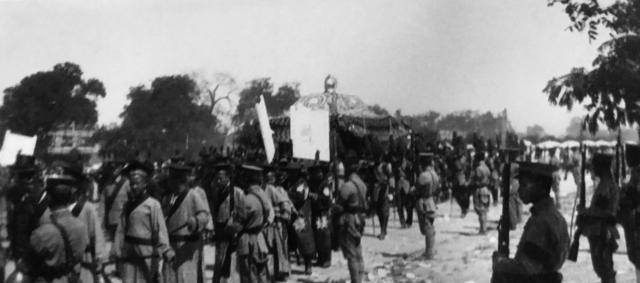
Yuan Shikai came out of the funeral scene and sent the funeral procession. On June 6, 1916, Yuan Shikai died of uremia. Because the Beiyang forces are still there, Yuan Shikai still enjoys great sorrow and honor despite the rebellion and separation, and his funeral is a mixed grand funeral of ancient and modern Chinese and foreign, emperor, concubine, state funeral and civil burial.
Yuan Shikai came out of the funeral scene, and there was a sea of people. After Li Yuanhong succeeded to the throne, he ordered a state funeral for Yuan Shikai, and the funeral instruments and ceremonial guards were of the highest class. On the day of the funeral, Yuan Shikai's coffin was carried out of Xinhuamen, from Zhengyangmen to Qianmen West Railway Station, and transported by train to Anyanghuan.
Yuan Shikai's coffin at the funeral scene. Yuan Shikai's will to Xu Shichang, Duan Qirui, and Wang Shizhen before his death said: "The remains of Yu Zhi should not be buried in the state, and the Yuan family should take care of it themselves." "But because of the insistence of some people in Beiyang, a thick state funeral was finally carried out with reference to Chinese and foreign canons." However, Yuan Shikai's will was quite unexpected, and he was obsessed with the imperial throne, and he no longer insisted on any emperor-sized funerals.
Around October 1900, Li Hongzhang sat on a bamboo palanquin, only one year after his death in 1901.
Today's Tomb of Li Hongzhang, but an empty tomb, there is certainly no bones of Li Hongzhang in it. Because in 1958, more than 50 years after Li Hongzhang was buried, his tomb was excavated and his bones were destroyed.
This huge tomb is the tomb of Li Hongzhang in Hefei, photographed in 1947, when it was not destroyed. In 1958, Li Hongzhang's tomb was destroyed, according to the recollections of the time: Li Hongzhang's body was covered with layers of cotton wool, wearing a yellow coat, well preserved, and the coffin contained a sword, a pair of glasses, a pocket watch, a stick, and a book. The book was his autobiography. The sword was taken away by a troupe as a prop.